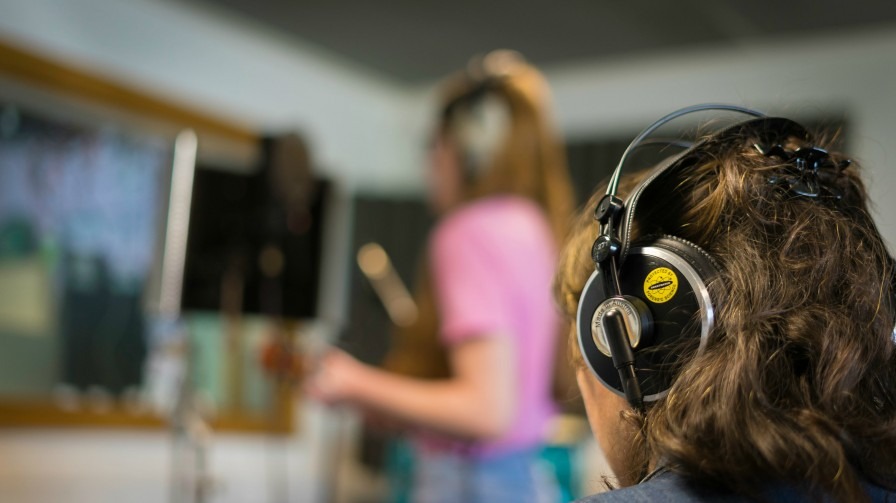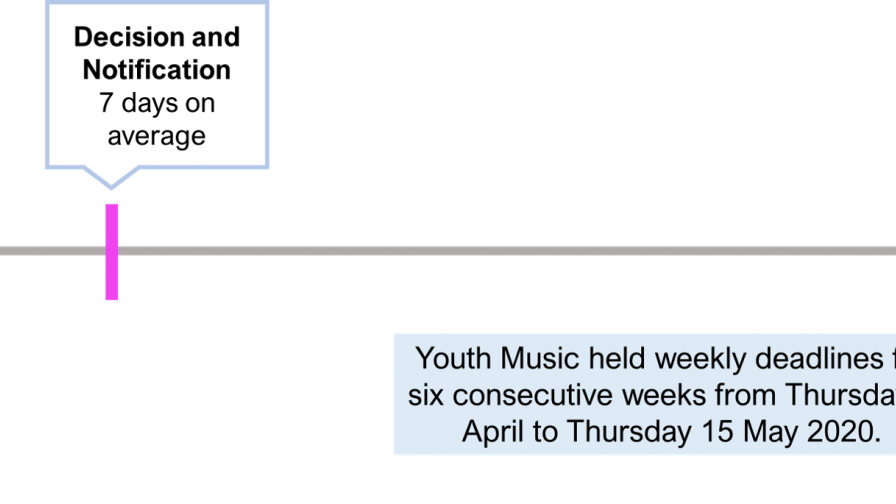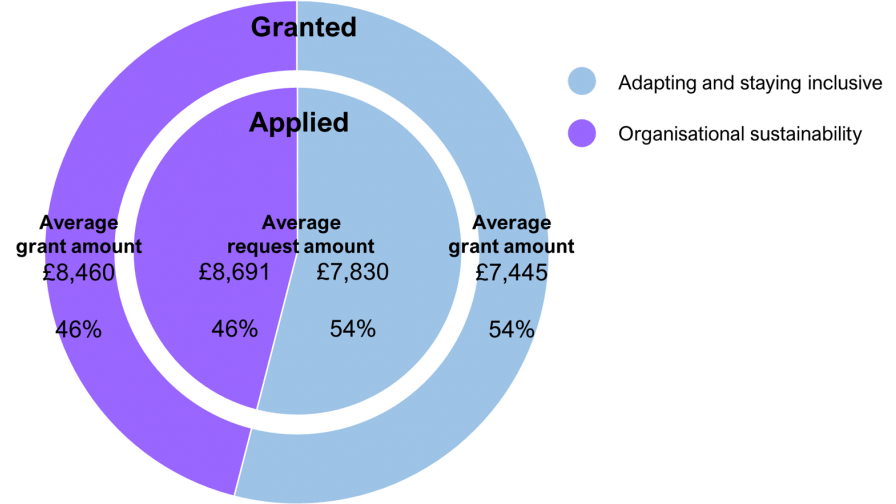Youth Music Emergency Fund - Findings So Far

On 1 April 2020 Youth Music launched an Emergency Fund, aimed at providing support to music-making organisations affected by COVID-19. We are still crunching the data and analysing the nature of applications to the Emergency Fund. For now, we wanted to share a summary of what we have learnt so far with a more detailed report to be released in due course. In our ongoing commitment to transparency, we are publishing the Emergency Fund grant data on 360Giving. (360Giving supports UK funders to publish open and standardised grant data).
The stats
Understanding that there was immediate and urgent need to be prioritised, we revised our usual application process with the aim of greatly reducing the time it takes to make decisions and payments. As a result, there were six weekly application deadlines, with 34 applications on average being assessed per week. At the time of writing, it took on average 29 days from submission deadline to a payment being made. It took on average 23 days from notification of decision to a payment being made.

We expected the Emergency Fund to be competitive, and it was. Sadly, we were unable to fund all of them. We received a total of 190 applications and funded 67 of them. We funded 35% of applications received with a total value of £551,309. The average request amount was £7,915 and the average grant amount £8,228. 54% of organisations that both applied and were funded are working towards ‘Adapting and staying inclusive’, with the remaining 46% dedicated to ‘Organisational sustainability’.

We also wanted to make it very clear that organisations did not need to hold nor have held a grant with us to be eligible or prioritised. Over half of organisations that were awarded an Emergency Fund grant do not currently hold grants within Youth Music’s main funding streams. 30% of grants were awarded to organisations that have never applied to us before.
It was essential to us that the diversity of funded organisations was consistent or higher than the applications we received. Around 60% of organisations that both applied and were funded defined themselves as diverse-led. Applications arrived from every region in the UK and at least a quarter of applications received per region were awarded. Although over a third of applications received were from London, 75% of grants were awarded to organisations outside of London.
We were able to build a clear picture of the makeup of organisations that applied to the fund. Smaller organisations and those with a low level of free reserves were common. We discovered that nearly half of organisations that applied (46%) and were funded (48%) had free reserves between 0-5% of their annual turnover. This is an important statistic that has implications for both our own and other funders’ future COVID-19 responses. Furthermore, 67% and 68% of organisations that applied and were funded, respectively, had an annual turnover of £250,000 or under.
Looking into the makeup of the workforce, freelance members of staff make up the dominant proportion of the organisations that applied to us. Only those enrolled in the PAYE system could access the UK government’s Coronavirus Job Retention Scheme. Of those that were eligible to access the scheme, many furloughed the majority of their PAYE employees but refrained from furloughing the whole workforce in order to continue some level of operations. There were many instances of organisations in which core staff kept working to continue to adapt and provide provision to young people, particularly those vulnerable and at risk.
This graph shows the proportions of payroll and freelance staff within the workforce of organisations funded via the Emergency Fund. Each vertical line is an organisation’s makeup.
How is the money being used?
There were two main priority areas to address immediate need within the Emergency Fund – Organisational sustainability and Adapting and staying inclusive. Teams working across the country in a variety of settings are innovating and adapting work to continue supporting young people that face barriers, particularly as the current circumstances potentially exacerbate isolation and risk. In common with existing Youth Music grantholders, many organisations have moved and are moving activities online: using a variety of platforms to keep in contact with young people, running workshops (group and 121), virtual choirs, expert Q&As, songwriting and ensemble performances, to name a few. (Check out this brilliant example from Fund A grantholder Freedom Road Creative Arts.) Some organisations are also creating pre-recorded resources for young people and their families to access in their own time and space. 121 sessions commonly include instrumental tuition or music-mentoring as well as pastoral support. Providing space for a young person to share how their week is going can be an invaluable interaction that is usually had but may be missed in the environment of an online call. Many young people are more likely to be impacted by this crisis as a result of the barriers they usually face. See here for our blog on supporting wellbeing during this period.
There’s another integral element missed from delivering sessions in an organisation’s venue: instruments and equipment. Many organisations discussed purchasing equipment for staff to use at home to continue facilitating activities. Examples of these include recording equipment to create resources to send out to young people and editing software to use with music created by participants. Others spoke about purchasing equipment to send out to young people directly to their homes, from iPads and laptops, recording/production equipment to be able to share their music remotely, to loaning instruments to practice at home, sometimes on rotation with other participants. Many organisations also acknowledged the specific actions and costs associated with the latter, considering the organisation of postage of these items to young people and ensuring that they have been properly sterilised between uses.
We also know that there are some immediate costs involved with moving activities online and supporting staff to do so. Paying for online conference platform accounts, maintaining websites and social media platforms, maximising marketing to reach as many young people as possible, administration costs and innovative campaigns, to name a few, were often mentioned in applications to the fund. Many teams found themselves adapting their skills, expertise and seeking essential training in safeguarding and working online. (We’ve been speaking to organisations throughout this period via virtual networks, have a look at the results of our conversations on safeguarding and engaging with young people through non-digital means. Visit our Coronavirus Resource Hub for more blogs and resources.)
Forward planning is key, and we are all considering what the future will look like and how it will impact our work. Many organisations told us that money is not only needed to cover core overheads such as rent and bills that are currently ongoing, but obtaining new spaces and investing in measures that ensure environments are appropriate for face-to-face delivery when it is safe to do so. Financial support packages offered by the government such as the Coronavirus Business Interruption Loan Scheme and the Bounce Back Loan Scheme, if eligible in the first place, were seen as a last resort for some organisations due to the uncertainty of future financial security. The majority of organisations that applied to the Emergency Fund depended on income of fees from delivering workshops, performances and fundraising events during what is usually a particularly busy spring and summer period, of which many have either been postponed or cancelled. As well as missing out on income from fees and their own fundraising initiatives they had also been impacted by the closure of several major funding streams (shut by funders whilst they focussed on their COVID-19 responses) which had been included in their annual budget forecasts.
The future
We have scrutinised the data in detail in order to inform our medium and longer-term response. We know this will need to be flexible enough to adapt to the ever changing situation and anticipate a range of future scenarios. A continued focus for Youth Music will be people and organisations who might otherwise miss out because of who they are, where they live or what they’re going through. From organisational sustainability to programme delivery, many organisations are succeeding in connecting with young people during a period that has forced distance between all of us. There is an ongoing conversation about how we can address, both as a funder and as an organisation within our sector, working towards equality and equity in our community, particularly as we transition to supporting young people face-to-face in the future.
We are grateful to our supporters for making the Emergency Fund possible: players of People’s Postcode Lottery, PayPal, and the National Lottery via Arts Council England.





